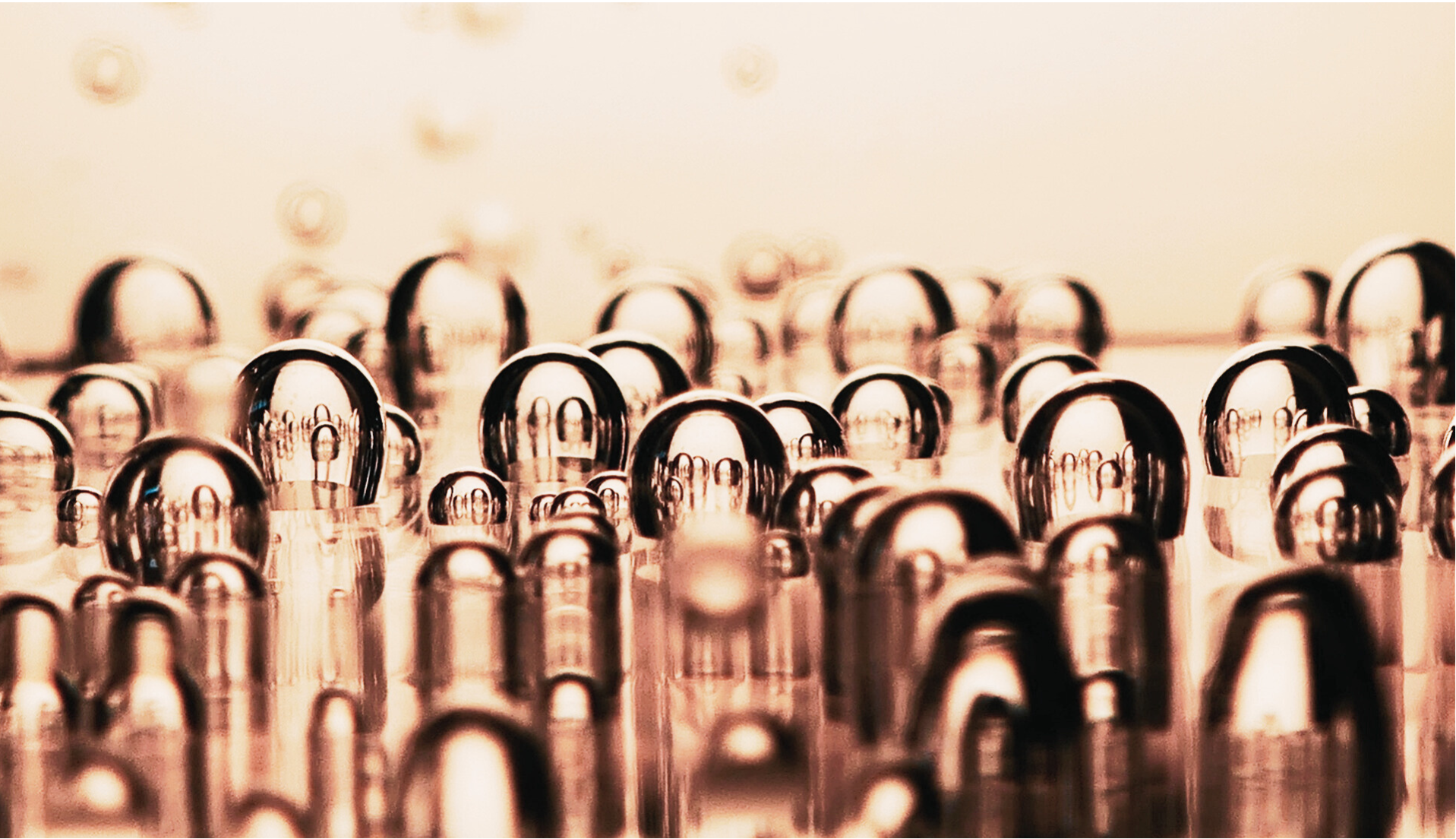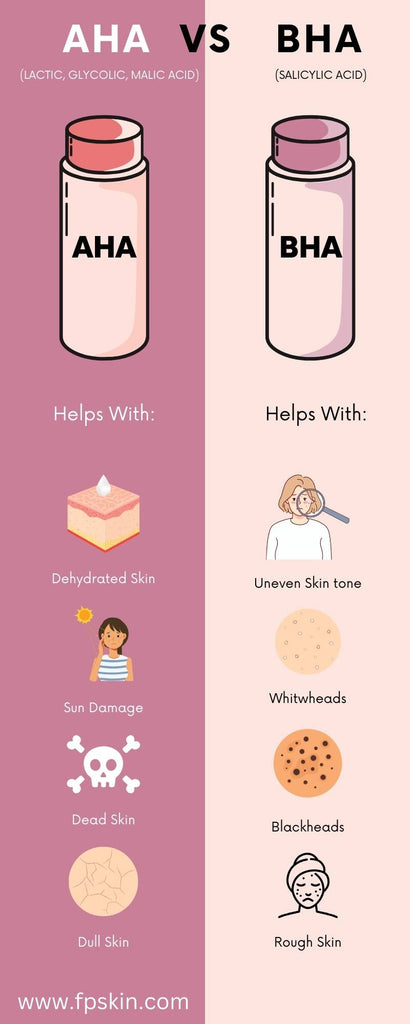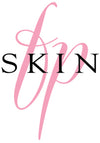
In This Article
- What are AHA and BHA?
- What is the difference between AHA and BHA?
- How do AHAs Work?
- How does BHA Work?
- How to Choose Between AHA and BHA
- What are the Potential Side Effects of AHA and BHA
- Common Side Effects of AHA Use
- Common Side Effects of BHA Use
- How to Reduce Side Effects and Stay Safe
- Is it OK to use AHA and BHA together?
If you want to achieve a radiant, healthy complexion, exfoliation needs to be an essential part of your skincare routine.
As we age the natural exfoliation process slows down or stops, so a little boost from exfoliating products can help maintain our youthful complexion. Yet, the quest for smooth, rejuvenated skin extends beyond the familiar scrubbing and grit of traditional exfoliants. Enter the world of chemical exfoliants, AHA (Alpha Hydroxy Acid) and BHA (Beta Hydroxy Acid) – two potent forms of exfoliating acids that may seem overwhelming at first glance. While it's not a matter of one being better than the other, these acids cater to diverse skin needs and types.
Furthermore, many exfoliating products (Control, Balance), blend both AHA and BHA, offering a multi-functional approach to addressing various skincare concerns.
What are AHA and BHA?
Alpha Hydroxy Acid (AHA)
AHA is a group of water-soluble acids primarily derived from natural sources like fruits and milk. The most common AHAs used in skincare are:
- Glycolic Acid: Obtained from sugarcane, glycolic acid is one of the most widely recognized AHAs, known for its exfoliating properties and ability to improve skin texture.
- Lactic Acid: Sourced from the fermentation of plant sugars, lactic acid is a gentler AHA that helps with exfoliation and hydration.
- Malic Acid: Found in apples and pears, malic acid offers a milder exfoliation and contributes to a refreshed complexion.
- Citric Acid: Derived from citrus fruits, citric acid is an effective exfoliant and also provides antioxidant benefits.
Beta Hydroxy Acid (BHA)
BHA, on the other hand, is lipid-soluble and is typically salicylic acid. Salicylic acid is naturally found in the bark of willow trees. Its oil solubility enables it to penetrate and exfoliate within the pores, making it a popular choice for combating acne, blackheads, whiteheads, and clogged pores.
What is the difference between AHA and BHA?
Solubility:
- AHA is water-soluble, making it effective at exfoliating the surface of the skin.
- BHA is oil-soluble, allowing it to penetrate deep into the pores, making it particularly beneficial for addressing issues like acne and blackheads.
Suitability:
- AHA is well-suited for those with dry or sun-damaged skin, as it helps to improve texture and reduce the appearance of fine lines.
- BHA is an excellent choice for individuals with oily or acne-prone skin, as it targets clogged pores and reduces inflammation.
How do AHAs Work?
The magic of AHAs lies in their ability to break down the glue-like substance (desmosomes) that holds dead skin cells together. When applied to the skin, AHAs gently weaken these bonds, effectively encouraging the shedding of the topmost layer of dead and dull skin cells. As the outer layer is removed, it reveals the fresh, radiant skin beneath.
Moreover, AHAs help accelerate the skin's natural shedding process, which tends to slow down with age. This boost in cell turnover is particularly beneficial for individuals with uneven skin texture, fine lines, or signs of sun damage.
Regular use of AHAs can lead to a range of positive outcomes for the skin, including:
- Improved Texture: By removing dead skin cells and stimulating cell turnover, AHAs result in a smoother, more refined skin texture. This is especially beneficial for those with rough or uneven skin.
- Reduced Signs of Aging: AHAs help reduce the appearance of fine lines, wrinkles, and sunspots. Their exfoliating action promotes collagen production, essential for maintaining skin firmness and elasticity.
- Enhanced Hydration: Some AHAs, like lactic acid, have humectant properties, meaning they can attract and retain moisture in the skin. This contributes to better skin hydration and a more radiant complexion.
How does BHA Work?
Salicylic Acid (BHA) exerts its exfoliating magic by diving deep into the pores. Once it enters the pores, it dissolves and breaks down the mixture of oil, dead skin cells, and other debris that clogs them.
BHA effectively unclogs pores, reducing blackheads, and whiteheads, and preventing future breakouts. BHA's anti-inflammatory properties help soothe and calm irritated skin, making it an excellent choice for those with acne-prone or sensitive skin.
BHA offers several benefits for the skin, making it a popular choice in skincare routines:
- Acne Treatment: BHA is particularly effective in treating acne because it can penetrate deep into the pores to clear blockages, reduce inflammation, and prevent new breakouts. It's known for its ability to target acne at its source.
- Reduction of Blackheads and Whiteheads: BHA's unclogging action is highly effective in reducing the appearance of blackheads and whiteheads. By dissolving the debris that causes these blemishes, it leads to a smoother and clearer complexion.
- Exfoliation and Skin Renewal: BHA promotes skin cell turnover, which leads to a fresh, radiant complexion. It can help fade acne scars and hyperpigmentation over time.
- Oil Control: BHA's oil-soluble properties make it ideal for regulating excess sebum production, which is beneficial for those with oily skin.
How to Choose Between AHA and BHA

Alpha Hydroxy Acids (AHAs) are well-suited for individuals with the following skin types and concerns:
- Normal to Dry Skin: AHAs, such as glycolic and lactic acid, are excellent choices for those with normal to dry skin. These acids provide gentle exfoliation and help improve skin texture and hydration
- Aging Skin: AHAs are effective at addressing signs of aging, including fine lines, wrinkles, and sunspots. They stimulate collagen production and promote a more youthful appearance.
- Dull or Uneven Skin Tone: If you have uneven skin tone or suffer from dullness, AHAs can help reveal a brighter complexion by sloughing off dead skin cells.
Beta Hydroxy Acid (BHA), often in the form of salicylic acid, is ideal for individuals with the following skin types and concerns:
- Oily or Acne-Prone Skin: BHA is particularly effective for those with oily or acne-prone skin. It can penetrate deep into the pores, unclogging them, reducing inflammation, and preventing breakouts.
- Blackheads and Whiteheads: BHA is excellent for reducing blackheads and whiteheads by dissolving the debris that clogs pores, leading to clearer skin.
- Sensitive or Rosacea-Prone Skin: Some individuals with sensitive skin may find BHA to be a more suitable exfoliant, as it has anti-inflammatory properties and is generally gentler on sensitive skin.
What are the Potential Side Effects of AHA and BHA
Common Side Effects of AHA Use
- Skin Sensitivity: AHAs can make your skin more sensitive to the sun. This may lead to sunburn if adequate sun protection is not used.
- Irritation: Some individuals may experience redness, stinging, or burning sensations when using AHAs, especially if the product has a high acid concentration.
- Peeling or Flaking: Excessive use of AHAs can lead to peeling or flaking skin, which may occur if the product is too strong or not properly diluted.
Common Side Effects of BHA Use
- Dryness: BHA can be drying, especially if used too frequently or in high concentrations. It can lead to dry or flaky skin.
- Initial Breakouts: When you start using BHA, you might experience an initial breakout as the acid helps unclog pores. This can be temporary but may be bothersome.
- Irritation: BHA can cause skin irritation, particularly for those with sensitive skin. Redness and stinging are possible side effects.
How to Reduce Side Effects and Stay Safe
- Patch Testing: Before applying AHA or BHA products to your face, conduct a patch test on a small area of skin to check for any adverse reactions.
- Start Slowly: Introduce AHA or BHA products gradually into your skincare routine, using them a few times a week and then increasing frequency as your skin tolerates.
- Sun Protection: Always wear sunscreen during the day when using AHAs or BHAs, as your skin may become more sensitive to the sun's harmful rays.
- Moisturize Following AHA or BHA application, apply a moisturizer to keep your skin hydrated and minimize dryness.
- Consult a Professional: If you experience severe irritation or side effects, consult a dermatologist or esthetician for guidance and adjustments to your skincare routine.
Is it OK to use AHA and BHA together?
Yes, using both Alpha Hydroxy Acids (AHAs) and Beta Hydroxy Acids (BHAs) together in your skincare routine can provide several benefits:
- Comprehensive Exfoliation: AHAs primarily work on the skin's surface, providing gentle exfoliation and improving skin texture, while BHAs penetrate the pores to remove deep-seated impurities. Together, they offer comprehensive exfoliation, leaving your skin smoother and clearer.
- Combating Acne: BHAs are effective at unclogging pores and reducing acne breakouts, while AHAs can help fade acne scars and even out skin tone. The combination can address both active acne and post-inflammatory hyperpigmentation.
- Enhanced Radiance: AHAs, with their surface exfoliation, can make your skin look brighter, while BHAs help maintain a clear complexion. The combination results in a radiant and even-toned skin appearance.
- Improved Absorption of Other Products: Exfoliating with AHA and BHA can help your skin absorb other skincare products more effectively. Serums and moisturizers may penetrate deeper, maximizing their benefits.
- Addressing Various Skin Concerns: By using a product with both AHAs and BHAs, you can simultaneously target multiple skin concerns saving time and money.
Disclaimer: Content found on www.fpskin.com, including text, images, audio, or other formats were created for informational purposes only. The Content is not intended to be a substitute for professional medical advice, diagnosis, or treatment. Always seek the advice of your physician or another qualified health provider with any questions you may have regarding a medical condition. Never disregard professional medical advice or delay in seeking it because of something you have read on this website or blog.

Comments (0)
Back to Blog